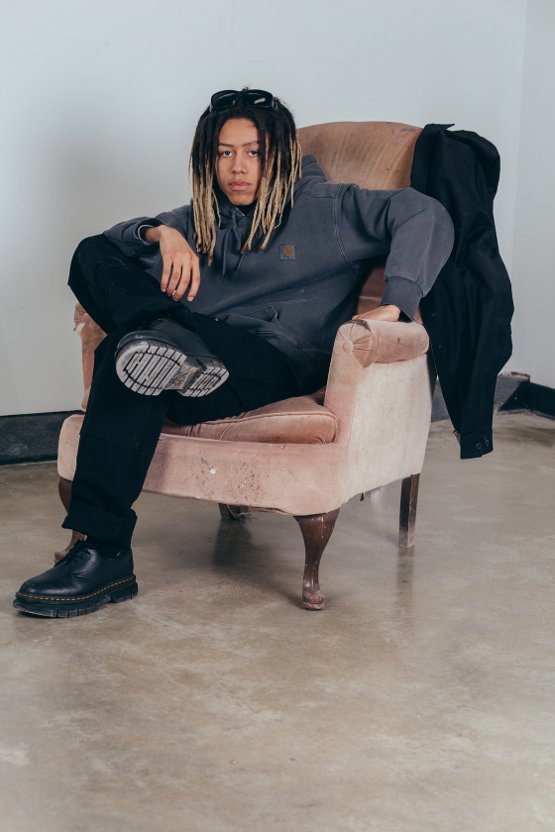

Since dropping their eponymous debut album in 2022, HiTech have garnered a reputation for being one of the most exciting and innovative acts to have emerged from Detroit in recent years. Their sound draws on various disparate and often slept-on genres to create something that could not have come from anywhere else than the D.
For this month’s edition of Carhartt WIP Radio, the group have created a time-bending mix featuring tracks from their first album, as well as songs from their newly released project DÉTWAT, out on Omar S's FXHE label. The mix is an evolution of ghettotech, booty house, juke and footwork – in other words, their own unique ‘D-Warp’ sound.
Accompanying the mix is a feature taken from issue 08 of WIP magazine, which includes a series of images shot by Samuel Trotter and an interview by the writer DeForrest Brown Jr., who reckons with HiTech’s unique ‘vibe,’ tracing a lineage to the city’s musical canon.


Somewhere on the West side of Detroit, the MC-DJ-producer trio HiTech has hotwired a newly-optimized “high technology 808” sound. HiTech is composed of King Milo, Milf Melly, and 47Chops, each of whom eschews their government name for a post-internet identity, amplified by dastardly, comedically-timed lyrics detailing the highs, lows, and cash flows of everyday life. Their hybrid of rhymes over live electronic and CDJ-driven beats collapse regional Black American expressions of dance music – Atlanta trap, Jersey Club, and Chicago footwork – into the techno-vernacular blueprint of Motor City electronic soul and funk.
For HiTech, techno is a point of departure, taking the futuristic vision of one of its originators Juan Atkins, of cerebral home-studio performance music, and placing it in conversation with the street-level dance floor bops of Ghettotech or booty house. Their self-titled debut came as a result of a pre-master CDR of demos being passed to DJ and producer Omar S one night, and captures a moment in time at the beginning of Milo and Melly’s collaboration. On DÉTWAT, their second collection of tracks introduces 47Chops’ DJing skills to accelerate their previously time-dilulated beat tracks into freewheeling, fully formed studio music that rethinks electronic production for the club. Whereas most rap artists position the DJ-producer as a backstage accessory, HiTech puts the music upfront and integrates musical expression with the MC-led party experience and beyond.

Bringing the vibe, setting the tone, and transitioning the mind, HiTech builds on recorded music and propels it into live spaces in search of universal frequencies, between the hardcore rave continuum of 80 to 190 BPM. “We were drenched in sweat after every performance,” says Milf Melly. “That's a guaranteed fact.” King Milo then remarks, “And soon we're about to start slipping and sliding and switching it up, and as intense as the show is now, we're about to bring another new element that's somewhat foreign to performance and especially techno, you know what I'm saying?”
“Everybody got they own frequency,” Melly continues. “The music that we're making is really touching everybody in such a way that we all vibing on the same frequency, and that's really hard to come by.” Milo adds: “Vibe is the look in somebody’s eyes.” Then 47Chops chimes in: “Your body physically matches that sonic vibration.”
The term “Hi-Tech” has a long history in Detroit, meaning to modernize older forms of music from the Black music continuum. Rapper King Milo helms the group’s sound and vocal production, stating that they chose the name “HiTech” because “you feel ‘high’ when you hear our version of techno, the vibes vary from song to song, and send you on a roller coaster of emotions and joy.” With the motto, “We facilitate the Vibe,” HiTech re-engineers the dance sounds of Detroit into a shifting head and body music mosaic. “I ain't gonna lie, this techno shit can go a wild, myriad of ways,” Milo says. “[Techno] is about putting people onto things, and making them dance and really think about all these real life statements and bars.” Techno’s futuristic intentions interest Milo as a means of steering his taste in underground hip hop and “Dirty south” rap towards more experimental directions. Whereas Milf Melly – who raps, produces, and designs HiTech’s merch and visual identity – sees Ghettotech as “concrete jungle music” that depicts the “inner structure” of the afro-utopian metropolises envisioned by Juan Atkins, Drexciya, and Jeff Mills among others, and illustrated by AbuQadim Haqq.

Arguably the only way to truly understand these soundscapes is to visit Detroit. Assembly line-based automotive and music industries in Detroit spurred an economic and cultural boom that attracted millions of Black people to migrate from the rural southern states. When the city collapsed throughout the 1980s, techno was a home-grown response that allowed Black youth to envision an alternate future amid the loss of another. “Ghettotech is definitely being in the present and hearing the ‘now’ in the moment,” explains Melly. Chops adds that Ghettotech is something that they all grew up with and would hear on the radio late at night. They explain that the “ghetto” element of Ghettotech comes from the lyrical content and the way that producers like Mr. Dé, DJ Assault, or Detroit in Effect see and speak about the world. “Drexciya is a really good example of cool dudes coming up with a whole concept, like building a whole world,” says Chops. “They got comic books. They bought a planet, you know what I'm saying? And named it and shit like that.” King Milo interjects, noting that Ghettotech is a homegrown popular music in Detroit, but hasn’t been recognized as playing a critical part in the futures of the young working class adults and Gen Xers, who first flipped techno’s hi-tech dreams to also encompass lo-tech realities.
Chops recounts the moments he began curating events and playing tracks, when people would approach him and say things like, “Bro, this is nostalgic. This reminds me of being a kid back in the day.” Milo asserts, “I was just a freak. I always liked me some freaky shit” and proceeds to sing DJ Assault’s Hoes Get Naked and Mr Dé’s Sex on the Beach. Milf Melly mentions being introduced to Ghettotech by his mom. “We used to have footwork and juke battles in the living room; and later on, I got into my own thing, then started discovering more music, like the Jersey and Baltimore styles.” HiTech emphasizes innovation, and leans towards a subtle progression that shows how expansive the Detroit techno blueprint can be.
Using a combination of electronic hardware and digital audio workstations, alongside instrumentalizing CDJs as an expansive sampler, 47Chops twists musical arrangements and concepts to create a sound that they like. “I would record something and then Milo would go in and like, tweak it and twist it, and do his thing. And then, if Melly has an idea, he'll add on to it and we kind of just think about what vibe we want to go for.” Chops was first introduced to DJing and event production through the party series Grand Bando, which repurposes abandoned buildings throughout Detroit into visceral rave spaces. “We brought in generators, speakers, projectors, all types of stuff and just created a whole vibe for people to come to and engage, interact, have fun, dance, all that good stuff,” he says. Later, he moved into Trumbullplex, a non-profit housing collective and event space established in Detroit in the 1990s, where he learned to book and audio engineer shows and pop-ups. “It’s definitely challenging, just being young and also living in a space where you're the person in control,” he says. “There's no landlord or person over your head. You're in the position to push this space forward and do it with other people. It's empowering. You can learn a lot if you're open to it. Whether it's about yourself, other people, even how to operate a space and do things with a community.”
 |
 |
 |
They describe HiTech as a group project where each member capitalizes on their individual skills while in conversation as an ensemble. “We feature a lot of people. So the dynamic of us performing these songs is kind of strange, but it flips all the time,” Chops says. “You're not going to have the same energy as on a track. It could be the same intention, but the energy will be all worlds apart. It's new energy every time.” HiTech’s studio conditions recall the original Underground Resistance lineup of “Mad” Mike Banks on the keyboards and drum machines, which were manually synchronized with Jeff Mills’ turntables, as Robert Hood would broadcast militant rhythmic speeches on the microphone. Underground Resistance’s 1990 compilation Hype Stuff (You Gotta Move To) exchanges the brutalist industrial body music of their X-101 project for a commercially viable fusion of hip hop and techno that could very well lay the groundwork for HiTech.
King Milo recalls watching an episode of Black Mafia Family set in a club in Detroit. “It was very nice, prestigious. You got to get your mink on and a suit to be let in,” Milo informs. “There was an electro funk song that was playing, and I was like, ‘Yo, I feel like that's the next stage of what we're supposed to be fuckin’ with.” Considering Detroit’s own history of members-only youth social clubs in the 1970s, Milo imagines the depiction of Detroit in Black Mafia Family to be a continuation of that tradition. The records that DJs like Ken Collier and Stacy “Hot Waxx” Hale were spinning were used with similarly self-built turntables and sound systems to synthesize new frequencies out of quatrain rhythmic blends. “No matter what I do, if I want a sound or vibration, I go and I try to mimic that vibration with my own equipment,” Milo comments. “If it makes me feel good, I'm all in. I just need something to wrap around. Something else so that the beats can fill up holes [in the music].” 47Chops adds, “From my perspective, coming into the music shit as a DJ first, you have to bring the vibe, set the tone for what people are going to be listening and dancing to at that time, in that space.” He explains that his transition from DJing into producing incorporates an element of beat matching with improvisation and arrangement. “I don't really know a whole lot of music theory, but I know what I like to hear.”
HiTech subscribes to an intentional use of beat structures and club genres in their productions without thinking too much about the particulars, and they allow for the emotions in the moment of the recording to mature overtime. King Milo describes the studio aspect of HiTech as a “multiversal” concept: “We started off with techno and just come in with bass and a kick and noise and lyrics–” “Freaking chords and all that good stuff,” 47Chops interjects. “We don came up with a little term, you know what I'm saying? D-Warp [Detroit Warp].” They insist that the term isn’t a genre, but more so a quality or technique that Milo says affects “the increase or the decrease in the speed in which we transition between songs.” He continues, “Sometimes that tempo increase or decrease will shift the whole song. And when you do it at just the right time, you can hear a shift in the sonics.” Milo excitedly explains that “so much stuff sounds faster when you just take away the kick and duplicate your hi-hats and you got five different hats going.” 47Chops mentions how this approach to production comes from a DJ’s mindset where a track cued at 160 BPM is slowed down to 80 BPM on beat before its snapped back into place. King Milo articulates that the instruments are sometimes “more keyed in” than the tempo. “Our thing is the new sound, you know. But it's nothing new about it, it's just a blend of different instruments at this certain speed that create this amalgamation of feelings. It's crazy.”
Words: DeForrest Brown Jr.
This article was taken from issue 08 of WIP magazine, available from Carhartt WIP stores and carhartt-wip.com.my.

![]()
